0.9 TCe GT Hatchback 5dr Petrol Manual Euro 6 (s/s) (110 ps)
Submitted by dev_editor on
It wasn't the most sensible or logical thing I've ever done, entering my Renault 5 long-termer in the Watergate Bay Sprint, a Cornish motorsport event on a closed public road between Newquay and Watergate Bay, about a month ago.
I mean, how well could a brand-new, bog-standard baby EV be expected to do in a proper, Motorsport UK-approved competitive event against 70-odd conventional cars, many of them developed over years for this very purpose?
Three reasons. First, this is the big-battery, 148bhp version. Its acceleration off the mark is much more impressive than that of a similar-power petrol car, because its generous maximum torque of 181lb ft is available from step-off.
As well as being invaluable in the traffic, such grunt is ideal for rapid start-line departures and for slingshotting you off start lines and out of slow corners and chicanes (of which Watergate Bay's 930-yard course has three).
Second, I reckoned the Renault's small size would help in a September sprint when the weather might be iffy (it was). And third, I figured the Pop Yellow colour would look great in photos (it did).
Debacles aren't often fun, but this event was one of the exceptions. The weather - rain and high winds - combined to make our clifftop perch about as exposed as it could be.
Extreme wet, mud on the track and an early competitor's accident (including a very big oil spill) combined to limit our number of runs to three (one practice, two timed) for the day, instead of the half dozen we had hoped for. Yet the car was terrific.
It ran a best time of 39 seconds - nothing special but no disgrace. It felt safe and quick, with positive steering and total wet-road stability. Even with rivers of water running down the middle of the track, I felt it could easily have used more power.
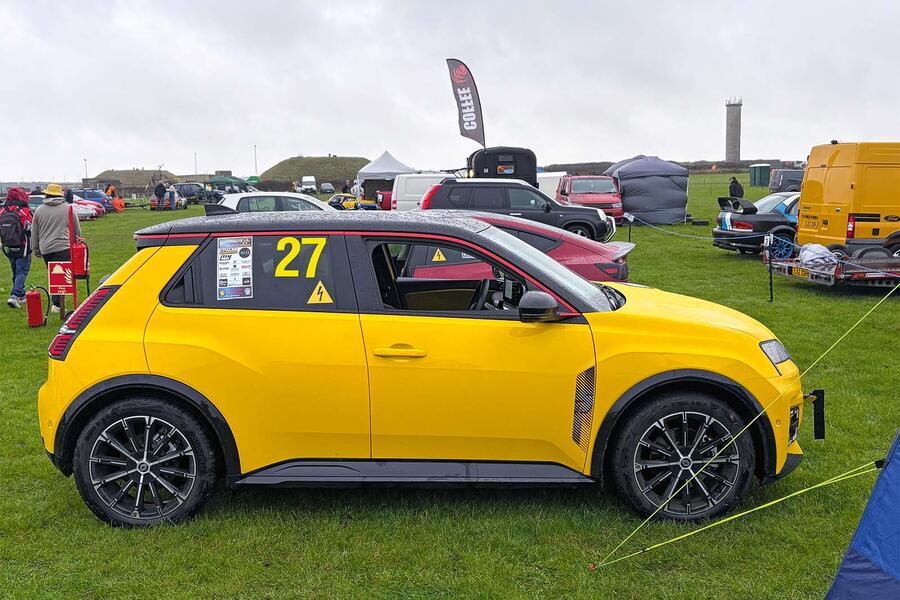
In our little EV class, I was easily beaten into third by a pair of Tesla Model 3 Performance entries, but I beat a game local entrant in a Nissan Leaf. On a dry track with a more capable driver than me, the 5 could have sliced five seconds off my best time, and a 5-based Alpine A290 a couple more, but the main thing was that I had fun.
Perhaps our little group's biggest win was that of all the clifftop tents competitors were using to protect their gear from the awful weather, ours was the very last in the paddock to blow away...
The whole exploit didn't prove much else, except that it's perfectly easy to drive a 5 from London to Cornwall with one stop (the same number you would choose in a petrol car), relying on a range of 180 miles if you cruise at 65-70mph. You will get around 4.0mpkWh if you do, which is impressive.
My 5 has now passed 11,000 miles in a few months, because it brilliantly combines fun, practicality, park-anywhere compactness and sprightly performance in town or outside. Even though the 5 has been on sale in the UK for more than nine months and is becoming a reasonably common sight, people still stop me in the street after I've just parked to enquire what it's really like.
It's a long time since I've had a mainstream car with universal eye appeal. It must be galling for those who sell or own the Citroën ë-C3 or the Peugeot e-208 (two clear 5 competitors) to see how imperceptibly their cars slip into the mainstream traffic.
In fact, if you're looking for proof that really great styling can make a massive difference to car appeal and consequent sales, the success of the 5 must surely be the best example for many years.
Despite a pre-dawn flight to the UK, Laurens van den Acker, the hugely accomplished Renault Group design director, bounds out of the Rafale with enthusiasm. “This is like Christmas for me,” he beams.
Today’s festivities go back several months, when van den Acker mentioned that, despite being good friends with Marek Reichman, Aston Martin’s chief creative officer, he had never driven one of Gaydon’s finest. Such opportunities don’t usually arise when you work for a different car firm – but Autocar can make things happen.
So while van den Acker and Reichman reunite outside Aston’s HQ, parked close by are a mighty V12 Vanquish and a vivid yellow Renault 5. After swapping keys, the two design directors head out into the Warwickshire countryside, eventually to meet us at Caffeine & Machine.
The conversation has been edited for length and clarity.
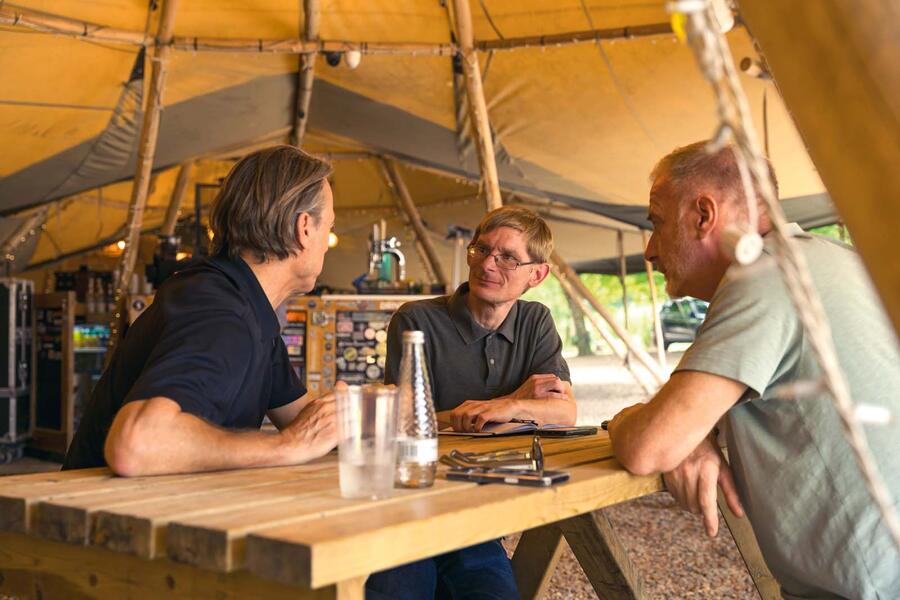
Autocar: How was the drive?
Marek Reichman: I tried to show Laurens some of the local historical points, and they’re very nice roads. These are our test bed: they’re typically British B-roads, with uneven cambers, potholes, undulations and tight corners. They’re exciting. Our car was developed for these roads, so you get the full sensation.
AC: Laurens, how did you find it?
Laurens van den Acker: To drive this car how it should be driven and where it should be driven, I’m a boy whose dream has come true. I don’t think I’ve ever experienced this type of acceleration before. I was laughing out loud. You feel the adrenaline pumping, and the car just invites you to go faster. I thought I would be intimidated by the Vanquish, but when you really push it, it wants you to come play.
AC: Marek, how did you find the Renault 5?
MR: It was really good. I haven’t driven one before but I know the roads, which helped with a beast like the Vanquish behind me. In terms of its response and excitement, it’s great. If you see an opportunity, you can take it. I even managed a bit of wheel screech at one point.
AC: Do you get the chance to drive cars from other manufacturers much?
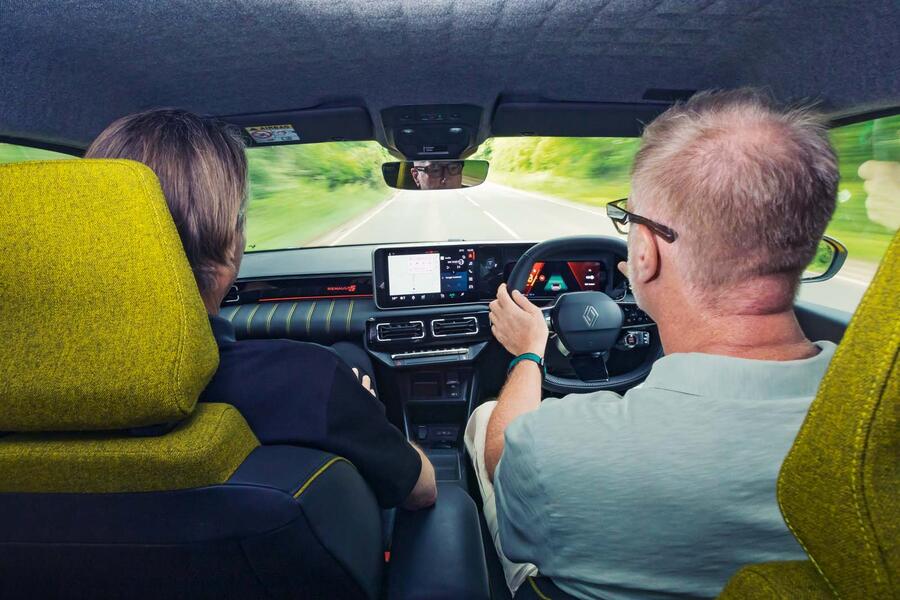
MR: We try demonstration vehicles from direct competitors, but very rarely outside of our category, so you take the chances when you can. When travelling I always book an entry-level hire car just to get the base experience.
LA: We’ll drive what we call the ‘golden car’ – the car we have as a benchmark – and lots of competitors from the class. We’re not in Aston’s league, although with Alpine it’s becoming more interesting, and we’re starting to drive cars from premium and sports car brands.
AC: Even when it’s in a different segment, are there things you learn when driving another car?
MR: Completely. In the R5 I spent a lot of my time checking out screen integration, the gap and flush of material change, materiality sections, detail changes and so on. You enjoy driving, but you spend your time looking at material finishes. But we’re fanatical, aren’t we? We go a little bit crazy. I’m looking for anything.
LA: The level of car you can get for the money now is incredible. Our idea was to get dream cars on the road. When [former Renault CEO] Luca de Meo came [in 2021], he didn’t want a difference between the promises we make and the cars we deliver. With the R5 we’ve never done a car where we’ve tried to be so close to the prototype. We really went for the last 5%. It’s like in Formula 1: those last few per cent have 50% of the impact. With car design there are now more possibilities than ever: this is a golden age for car design.
MR: Absolutely. It’s the inflection point in powertrain technologies, and there’s competition coming from all angles. There are more Chinese manufacturers and, in our world, more bespoke manufacturers coming into the ultra-luxury space. So it is a golden age, because there’s more competition and more desire to win.
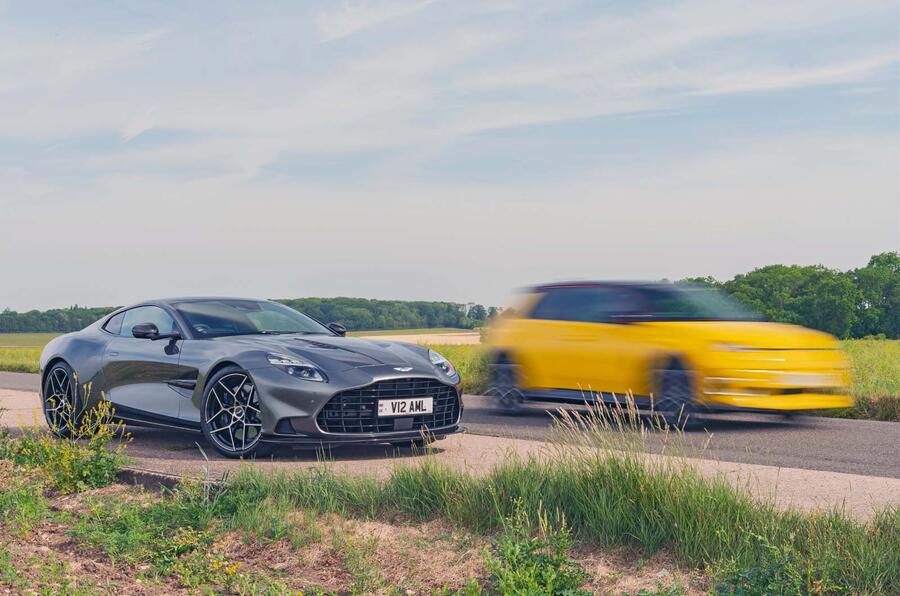
LA: You need that desire to drive you.
MR: Any designer or engineer is very competitive. I’ve played football with this man: I have a scar he gave me in a match, so I know how competitive he is. And part of the design profession is being competitive. It drives us.
AC: How long have you known each other? You were at Ford around the same time 20 years ago.
MR: We’ve known each other from before Ford. I started at BMW Designworks [in California]. And Laurens was…
LA: ...at [design consultancy] SHR. I left Audi in 1993 when J Mays [then Audi’s head of design] started SHR in California. BMW Designworks was up the road. We looked up our friends in the car design business and we all ended up living in the same area. We became friends very fast.
MR: We kept moving as a group as well. I eventually moved much closer to the beach in Laguna Beach. It was learning to surf and beach barbecues, basically.
LA: California was a good time. Then we ended up moving to Detroit. I was at Ford, and Marek joined through Lincoln. I saw this army coming in with Gerry McGovern, and Marek and David Woodhouse in his slipstream, to revive Lincoln from the ground up. Later, Marek was moved to Aston Martin, and I became design chief at Mazda.
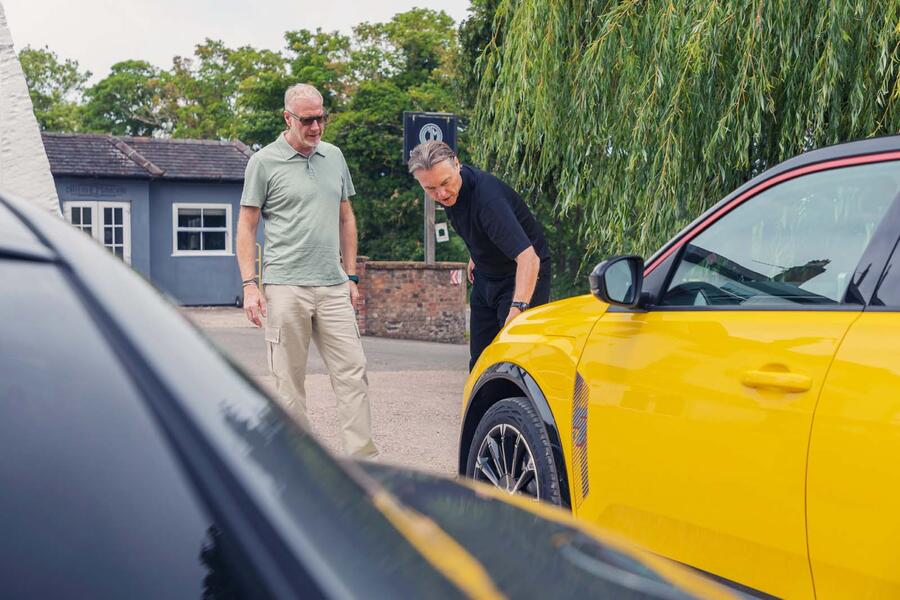
AC: Marek, you’ve ended up at a luxury firm, and Laurens, you’ve led mainstream brands. Do designers have a natural pull towards certain market segments?
MR: You go where the opportunity is, but it’s got to be the right brand. My route started with Land Rover when BMW bought it, which back then was an incredibly utilitarian product – very different from the brand it is today. But there are very few chief designer jobs in this industry.
LA: You don’t have the luxury to say ‘no, I’ll let this one pass and wait for the next’.
MR: These jobs don’t come up very often. Another friend of ours, Adrian van Hooydonk, has been at BMW for 30-plus years. If you look around automotive at the leaders in design, they’ve mostly been incumbent for some time.
AC: Someone like Miles [Nürnberger, the long-time Aston Martin designer who just returned to the firm after a year at Dacia] shows you can move between luxury and mainstream.
MR: We play tennis with Miles, batting him between us.
LA: Or ping-pong, maybe. I thought it was an inspired choice when Miles came for his brief honeymoon at Dacia. There’s quite a bit of similarity between the roles: you fight the same battles, just at the opposite end of the spectrum. High volume, low volume, high price, low price, the rules of design are the same. People say ‘Dacia must be tough because you have little money’. But I have friends at luxury brands who complain about not having enough money.
MR: With design, part of the remit is innovation. You have a budget, so how do you define it? You can spend it on a chunk of carbonfibre for a part, or a tool to make lots of plastic things. The shape is what we try to define; the materiality of that shape is set by your budget. With the Renault 5 you have volume.
LA: Which means we can do things you couldn’t do.
MR: You’ve got to find innovation. You’ve got to have a core component – which the consumer doesn’t see and which is based across everything.
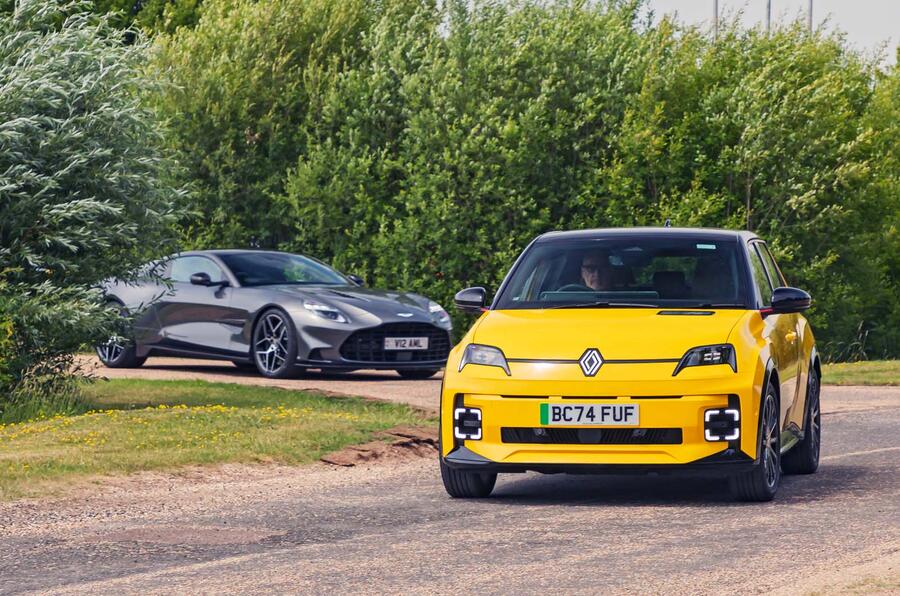
LA: Today, the level of design that you find in both premium and popular cars is nearly equal. It used to be that if you made a B-segment hatchback you’d see compromises everywhere. But look at the Renault 5: it’s parked next to an Aston Martin Vanquish and you can still appreciate it. Obviously we don’t have the power, but on a design level every aspect is treated with as much love.
AC: As a designer, do you learn from other cars on the road, regardless of class?
LA: For us, Aston Martin is a benchmark in design: it’s the whole brand experience. We’re learning a lot from Aston in how they position the car, how they advertise, how they use branding.
MR: You asked if we get inspiration from other cars: it’s everything, whether it’s fashion, product design, architecture, furniture – you’re constantly looking and absorbing. I spend my time saying ‘I knew you could do that’. If someone has told me you can’t do something and then I see someone else has done it, I will be such a pain in the ass.
AC: Do you recognise the work of other designers when you look at a new car?
LA: I hope so. You want a signature. You want it to be on-brand, and you want to see the imprint of the designer. There needs to be a ‘before’ and ‘after’ [a specific designer]. Obviously a car needs to reflect brand values, but you’re not going to design something you dislike, so you have a personal expression.
MR: With that personal expression we’re also defining the brand’s DNA as it changes over time. Like with your children, it’s a chain of DNA but they’re all different. So our role is to evolve that DNA through time and technology. As Laurens says, hopefully you see it. To me, Renault, Alpine and Dacia now feel more – and I can’t express the word in any other way – designed. They are more considered, there are more consequent things in those products than before.
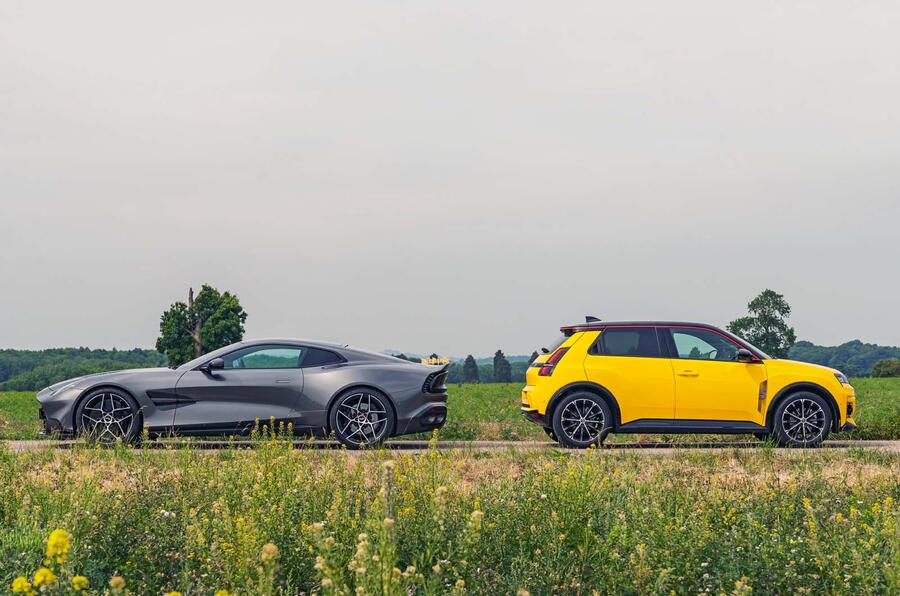
LA: Popular cars need to be flexible. We now have future icons and legendary icons, and they can live together. The brand is broad enough.
AC: Laurens, have you ever fancied trying your hand at designing ultra-luxury cars?
LA: Of course. Marek designs the cars that made us all start. If you looked at my bedroom walls as a kid I had Aston Martins and Ferraris and Lamborghinis and Pininfarinas on them. These are the cars that got us into design. Then you evolve, and now I enjoy doing an R5 or a Clio as much as I would do a sports car, or even a van.
MR: Or a Twizy…
LA: Yeah, a Twizy. We have four brands, and I love the diversity. But give us a sports car package and this would come naturally, it would be a dream. Luckily, with Alpine we have a chance.
AC: And the Renault 5 can hold its own: it has been parked next to a Vanquish and people have been taking photos of it.
MR: It has a fan base. Something like an R5 embodies an emotional reaction to some prior existence when you may have been five years old and sat in one, or you saw one being rallied.
LA: There is a reservoir of sympathy for these types of cars. But when you do one, you need to do it right. When people ask me what’s difficult about doing a new Renault 5, it’s that people know when it’s right and they know when it’s wrong. If we do a new Mégane, there are no rules. With a Renault 5 or an Aston Martin, people will tell you if it’s not right. If we do an R5 and we miss it, we’re screwed.
AC: Since Aston does relatively few cars, Marek, do you feel that pressure every time?
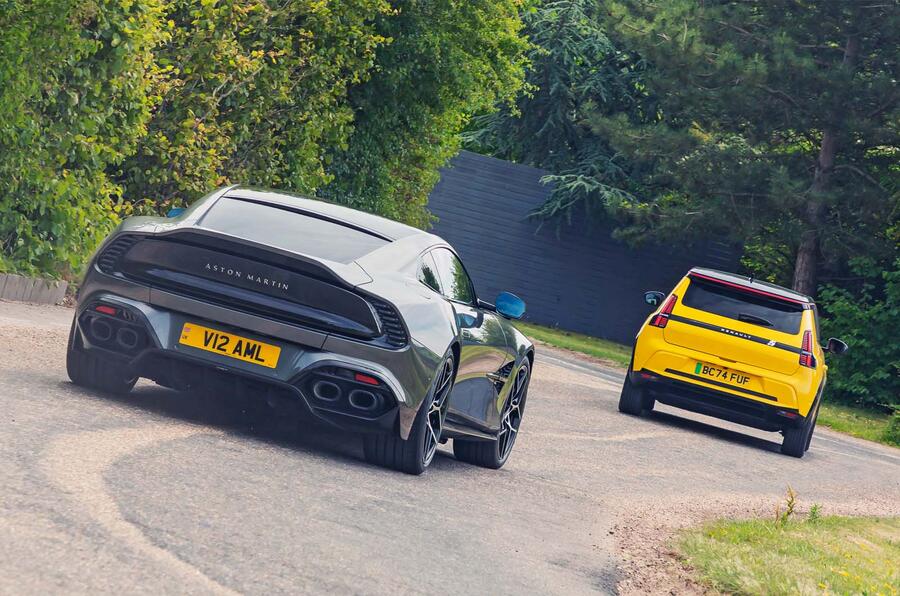
MR: Absolutely. In terms of our total sales volume it’s very few, but in terms of product I’m on car number 55 or 56 in 20 years, and with what’s in the pipeline now I’ll easily be at 64. That’s a lot of cars, especially because some are one-offs or limited runs.
AC: Would you like to design a mainstream model, though?
MR: I love the art of design, so the idea of doing something like a Renault 5 or a Twizy really appeals. You get to solve a very different problem.
AC: Laurens, is there anything you’ve ever wanted to ask Marek?
LA: To borrow his cars more often? No, from my perspective Marek lives the dream life. But he has seen Aston Martin go through all kinds of upheavals, and designers incarnate the brand, so we always have to put up a good face even in the darkest of times. So my question would be: how did you keep up the motivation?
MR: Do I have to answer that?
AC: Of course…
MR: It goes back to passion and pride. We become designers for a brand, and we have to imbue the brand. Sometimes my budget has been slashed and it’s mayhem in my head, but I’ve got to walk into a room of customers or journalists and represent the brand. But creatives are very fortunate – we can compartmentalise. It might be crap today, but designers live in the future.
LA: Whenever we’ve had a crisis, I tell the executive team the crisis is already done for me, because I’m working years in advance. For me there’s no chip crisis and trade barriers are long gone: I’m designing cars for when life is good.
MR: Right, what would I like to ask Laurens?
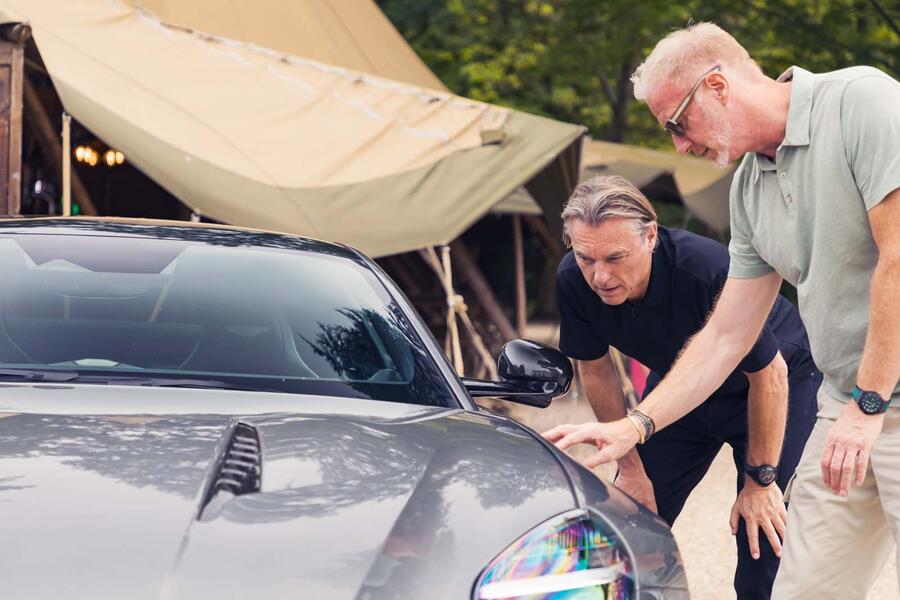
AC: At the moment my question, and he probably can’t answer it, is what is life going to be like without Luca de Meo?
LA: That’s a delicate question. The best answer I can give is that, for me, Luca is the Jürgen Klopp of the car industry. He brought in a lot of passion and a lot of success. He really lit a fire in the belly of everyone who’s a fan of Liverpool, and then he left. But look at where Liverpool is now. He left behind a good team, management and structure. So I hope we can repeat his success.
AC: Finally, we have to resolve this: what exactly happened with this football clash you two had?
LA: It was when we were both at Ford. He was a firm defender and I was a committed attacker…
MR: I tried to stop him. I was on the left side of the goal and he comes barging in, and I swear he used his head. I went off bleeding, and now I have a scar, because I was determined not to move and he was determined to just go by me.
LA: It was deserved, fully deserved. He should have been sent off…
Renault is poised to launch a range-topping performance version of the Megane E-Tech next year as part of a radical styling makeover that will reposition the EV as a hot hatch.
The move is motivated by a desire to revive the Megane E-Tech’s appeal and reverse a sharp fall in sales of the car over the past 18 months.
Speaking at the Munich motor show, Renault brand CEO Fabrice Cambolive confirmed the Megane E-Tech will be repositioned as “a hot hatch or a hot car”, adding: “That’s the direction we want to go in.”
He also told reporters that Renault is exploring the viability of a new performance model and will show the “first proposals” within 12 months.
While he declined to give further details, the two are expected to be linked.
The brand’s last true dedicated sporting model was the fourth-generation Megane RS hot hatch, which went out of production in 2023 with the 296bhp Ultime run-out special.
Renault has begun experimenting with sportier models again recently, bringing to market the exclusive, £140,000 5 Turbo 3E – a 533bhp hyper-hatch designed to show what a Renault performance EV is capable of.
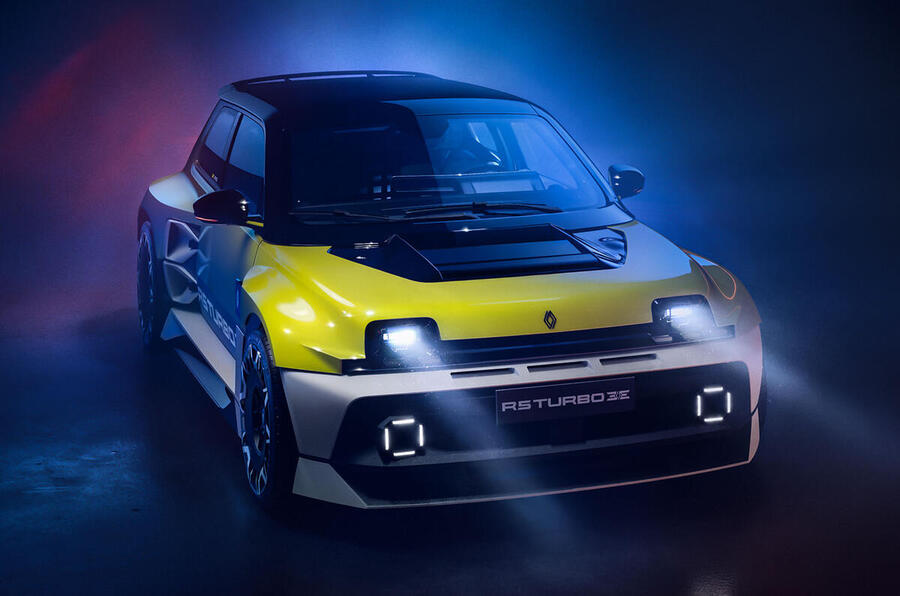
The new top-rung Megane E-Tech model isn’t expected to receive such a lofty power output, but a more feasible option is apparent from its Ampr Medium platform-mates.
Of those, the new Alpine A390’s bespoke 464bhp tri-motor powertrain isn’t likely to be transferred to the Megane E-Tech, but the Nissan Ariya Nismo’s 429bhp dual-motor set-up could be in play. The current Megane E-Tech is offered exclusively with a single electric motor and a topend output of 215bhp.
It is not yet known if the new range-topping Megane E-Tech will take the Renaultsport name.
Cambolive hinted that the Renault Group could decide to continue using the Alpine brand exclusively for dedicated sports cars.
Previously, in February, the Renault Group’s then CEO, Luca de Meo, described Renaultsport to Autocar as being “in the fridge” and said that while “everything sporty would be building on Alpine”, that “doesn’t mean that sometimes this thing wouldn’t be revived”.
On the viability of the Megane E-Tech rangetopper potentially spawning a series of new performance cars, Cambolive said “we have to find the right balance” between cost and demand before any approval is given.
To that end, Renault Clio product line manager Emmanuel de Jesus Pequeno recently told Autocar that a hot version of the new sixth-generation supermini is not currently on the cards. This is because of the “compromise” between the level of investment required to transform it into a hot hatch and the level of expected demand.
A refresh of the Megane E-Tech has been a big focus for Renault, said bosses. The model was launched in 2022 as one of Renault’s first new-age electric cars.
Following its initial success, the Megane E-Tech has subsequently been challenged by a growing number of newer rivals, some of which are delivering more for less than the hatch’s £32,495 asking price. As a result, sales have fallen sharply – down 67% (to 10,082) in Europe for the fi rst half of 2025 compared with the year before.
Speaking about the Megane E-Tech’s 2026 refresh, Cambolive said it will get a larger battery. This is likely to be the 91kWh pack used in the Ariya Nismo and Scenic. In the hot Nissan, the battery offers up to 310 miles of range.
Autocar understands the facelift will bring a new grille, new daytime-running lights and a lower, wider stance, although Renault Group design boss Laurens van den Acker would not be drawn into specifics.
On the need to refresh the hatch, van den Acker admitted: “We need to sell more of it.” He added: “If you put a new battery in the car, which is very expensive, and you don’t change the car, then it’s really hard to seduce people to pay more for it.
“So we needed to justify the change underneath the skin by showing something on the skin. And then we thought that what the world was missing was kind of a hot-looking EV. And so we thought we had nothing to lose, so we’ll just push that.”
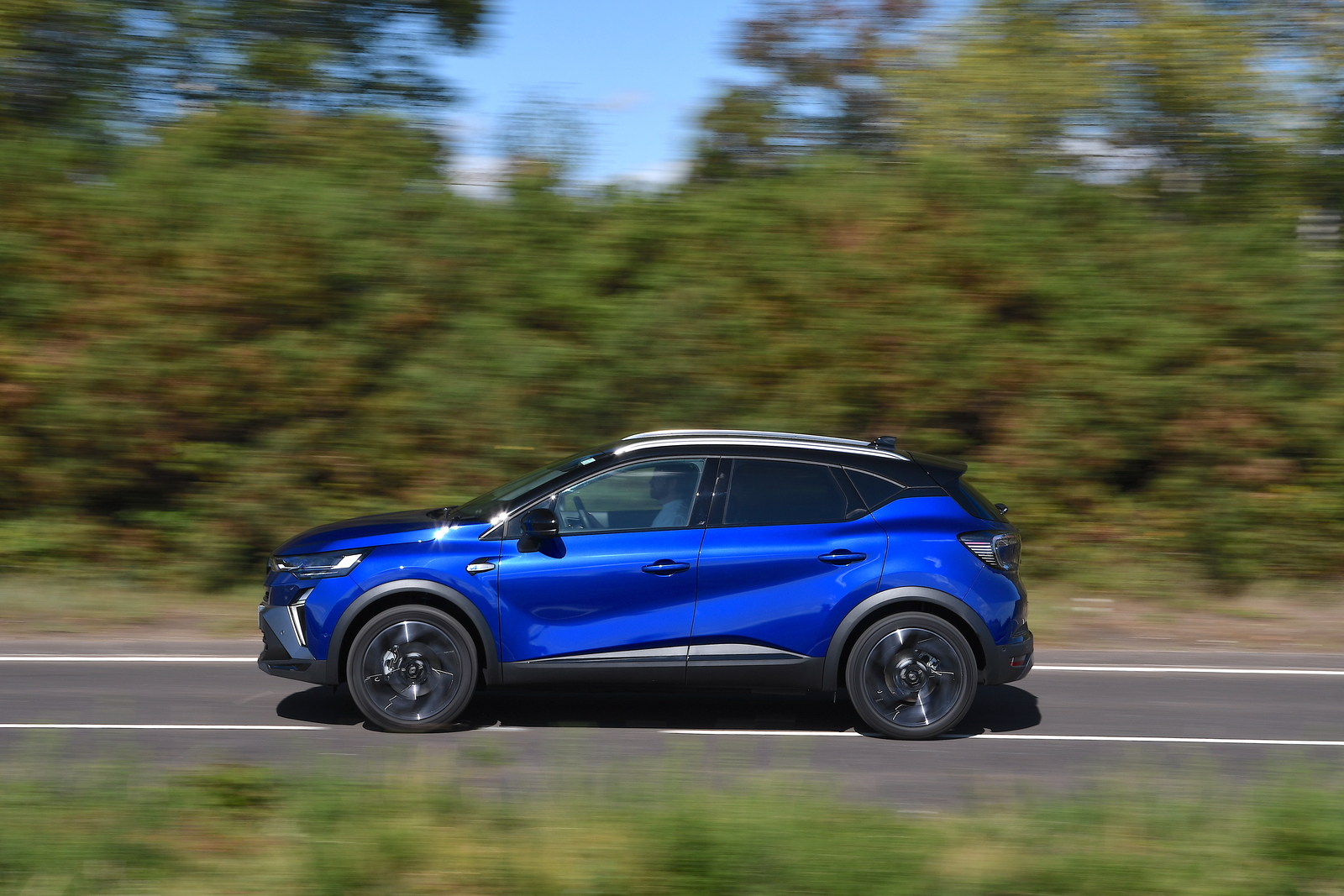
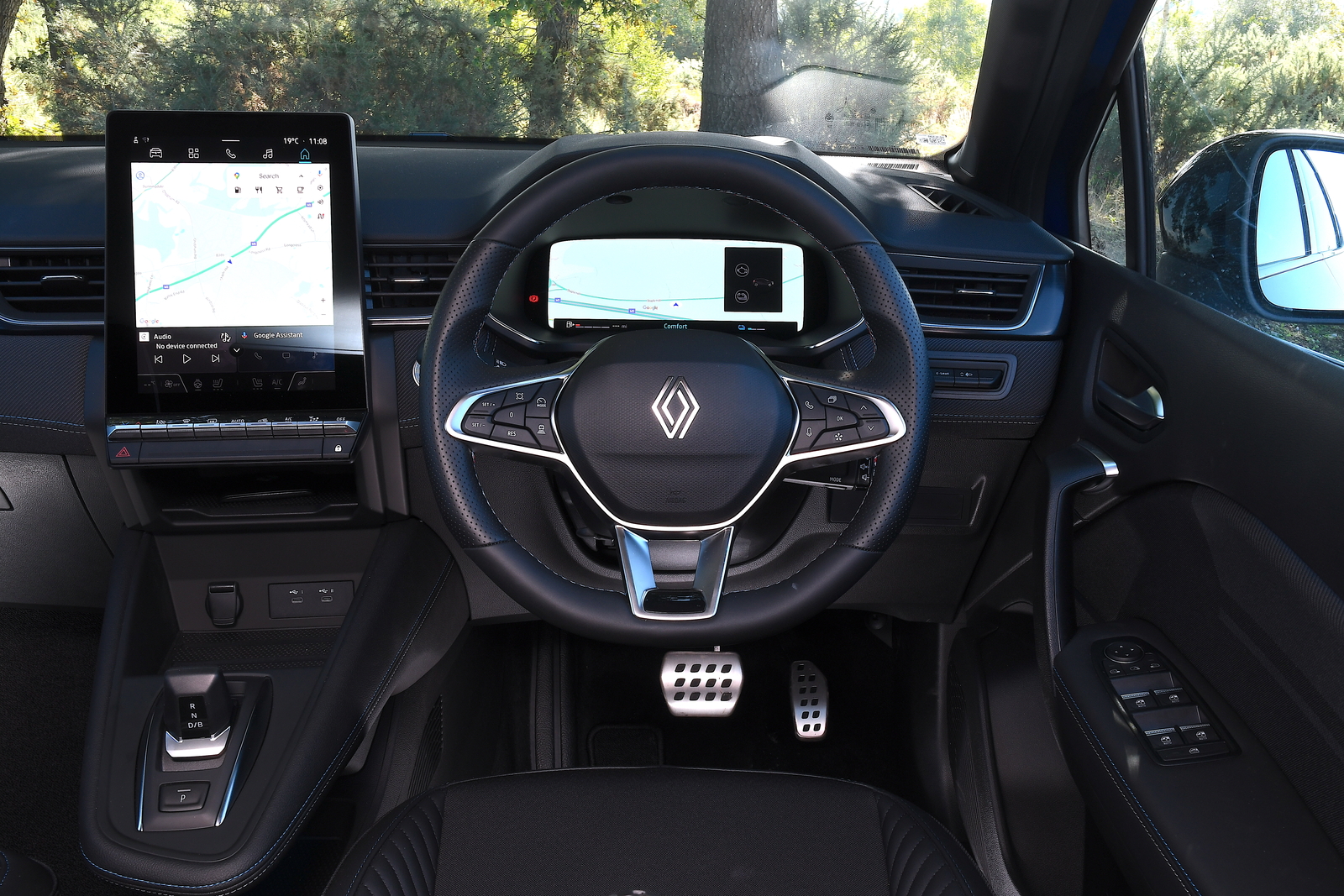
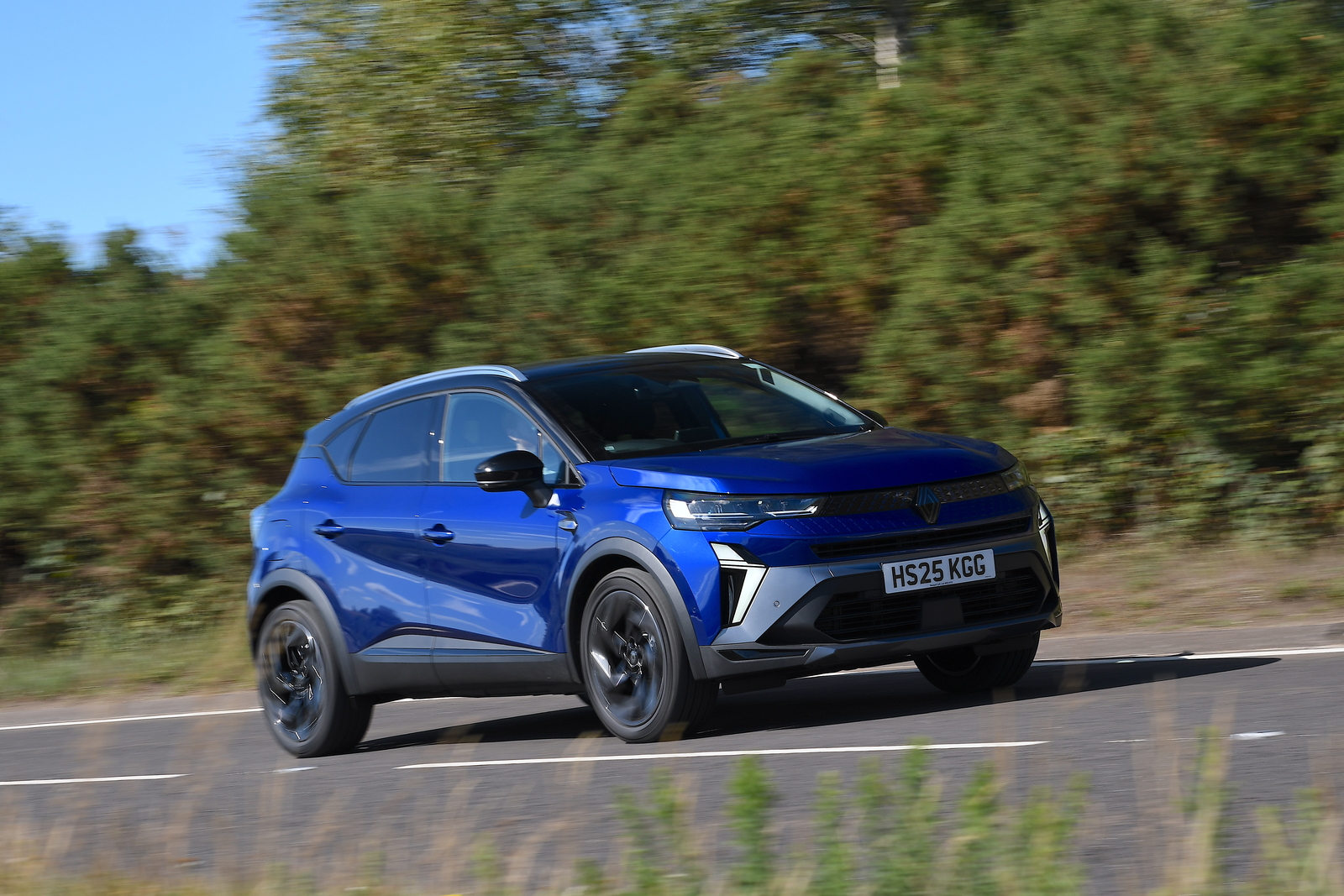
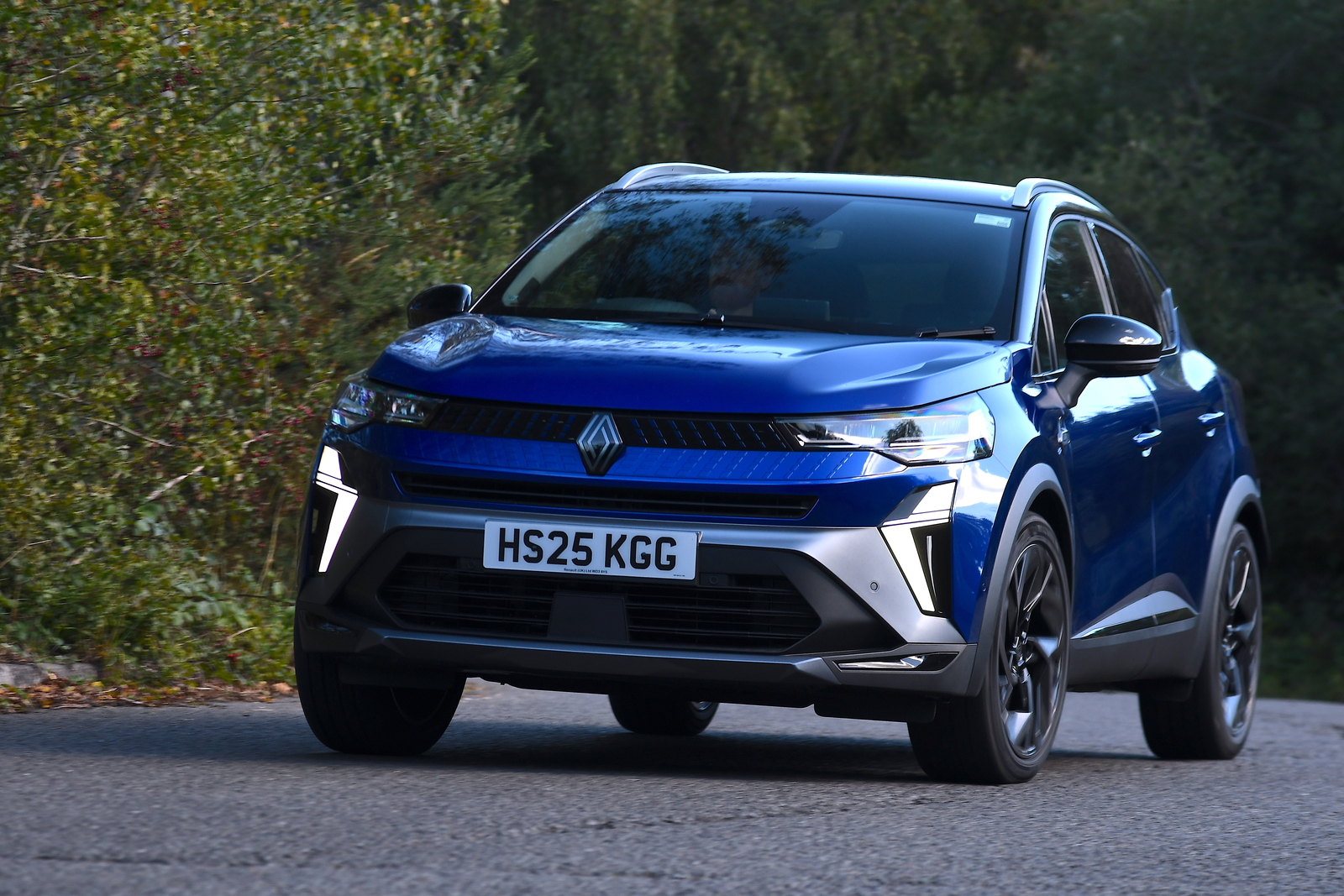
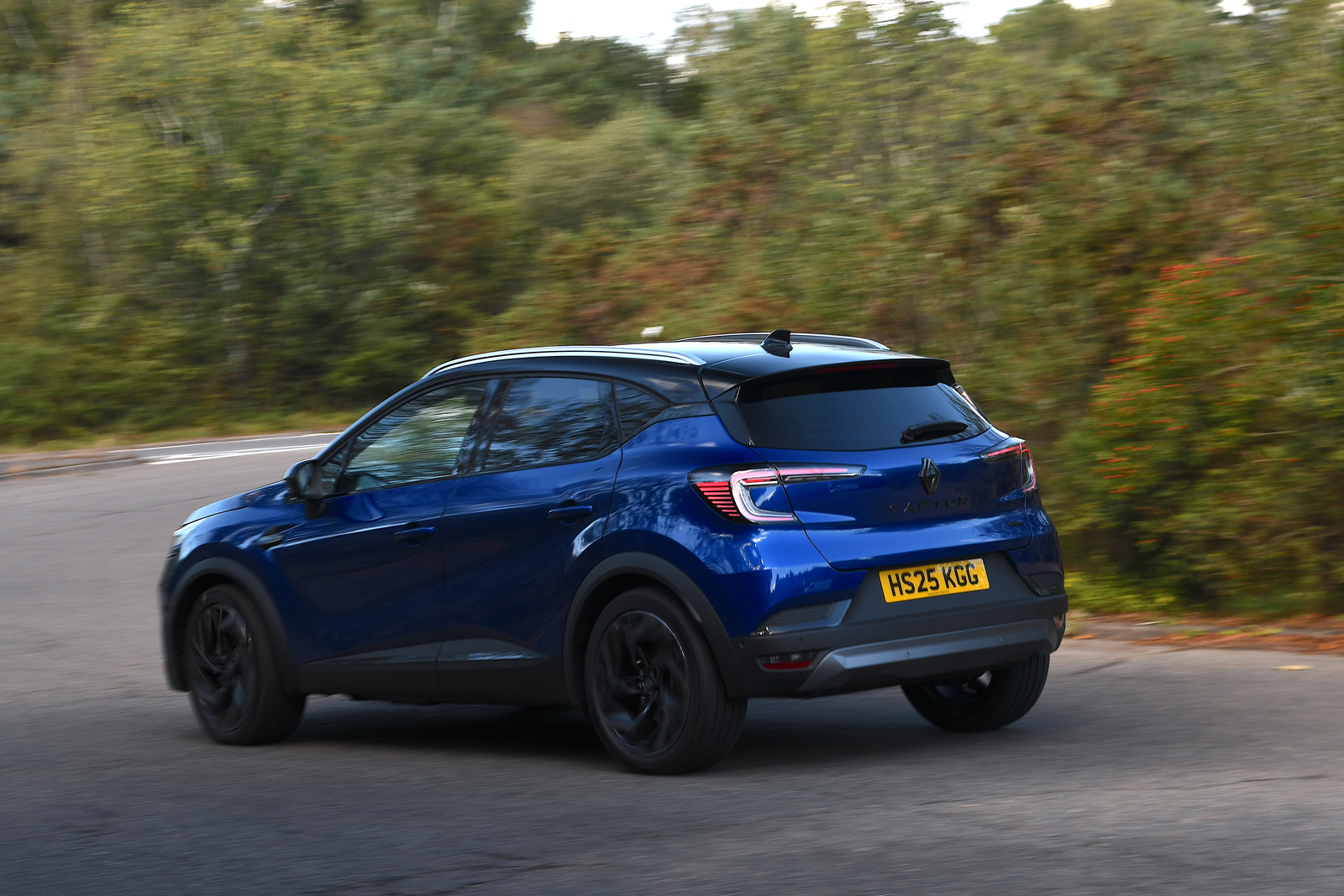
It’s a curious thing with hot hatches – they’re much lusted after when they’re the cars of the moment and the best of their breed.
But when that moment has gone and the next superheated hot hatch arrives, they fade as fast as a tropical sun. They get used up until suddenly, there are hardly any left. And fewer still that you’d give drive-space to.
The X85 generation RenaultSport Clio has yet to reach the decimation phase, but its X65 predecessor has despite this car being the hot hatch to have in its day. You’ll occasionally find a crisp Clio 182 with low-ish miles. But these are the exception - most have been thrashed, trashed or crashed.
But there signs that its successor may not quite go the same way. A tempting trip through the classifieds reveals several that have clearly been pampered, come with all the right bits and have a heap of life left in them. So perhaps the X85 Clio RenaultSport is going to buck the hot hatch trend, allowing a decent number of coveted and cared-for examples to survive. High prices potentially make it too expensive to track-day these machines to oblivion.
That said, a track is where you best experience the superb handling of this car, especially if it’s equipped with the coveted Cup option. Though if you’re shopping for an X85, you need to know that there were two ways to acquire this confection. In its most extreme form, the Cup option was not only about recalibrating the springs and dampers for still greater agility, but also about paring weight, specifically 20kgs-worth.
To make that gain, Renault deleted the air conditioning, keyless entry and curtain airbags, and installed the lower-rent dashboard of the most basic Renault Clio, complete with steering column adjustable for rake only. You could order the air conditioning and curtain airbags as options, but not the higher-grade dash, reach adjustment or keyless entry.
You paid £1000 less for this version – a refreshing contrast to Porsche, which will charge you (loads) more for an RS with less, but better still was that the Cup chassis could be ordered with standard car. In this form the Clio weighed only 1.6% more, making this the optimal choice. But if you’re shopping, you need to be sure of what you’re getting.
And what was so special about the Cup suspension? It wasn’t as if the standard car shortchanged in the gripping, turning, swerving and stopping departments. But those reworked dampers and springs tightened the Renault’s body control, deepened its athleticism and sharpened your impression of the tyres’ intimacies with the road below. And all without ruining the ride. The steering could still have weighted up more informatively when you got some boldness on in a bend, but the Clio Renaultsport Cup was unquestionably top of the pile, not least because of the lift-off, tuck-in liberties you could take with this wonderfully game chassis, and a revvy engine to goad you on.
It’s still hard to beat even now. One major reason for that is that its paddle-shift only, five-door successor doesn’t quite continue the magic, despite Dieppe’s effortful fettlings. But the main reason is that the X85 Clio RenaultSport remains one of the best-handling front-drive cars of all time. With luck, that will mean plenty of survivors.
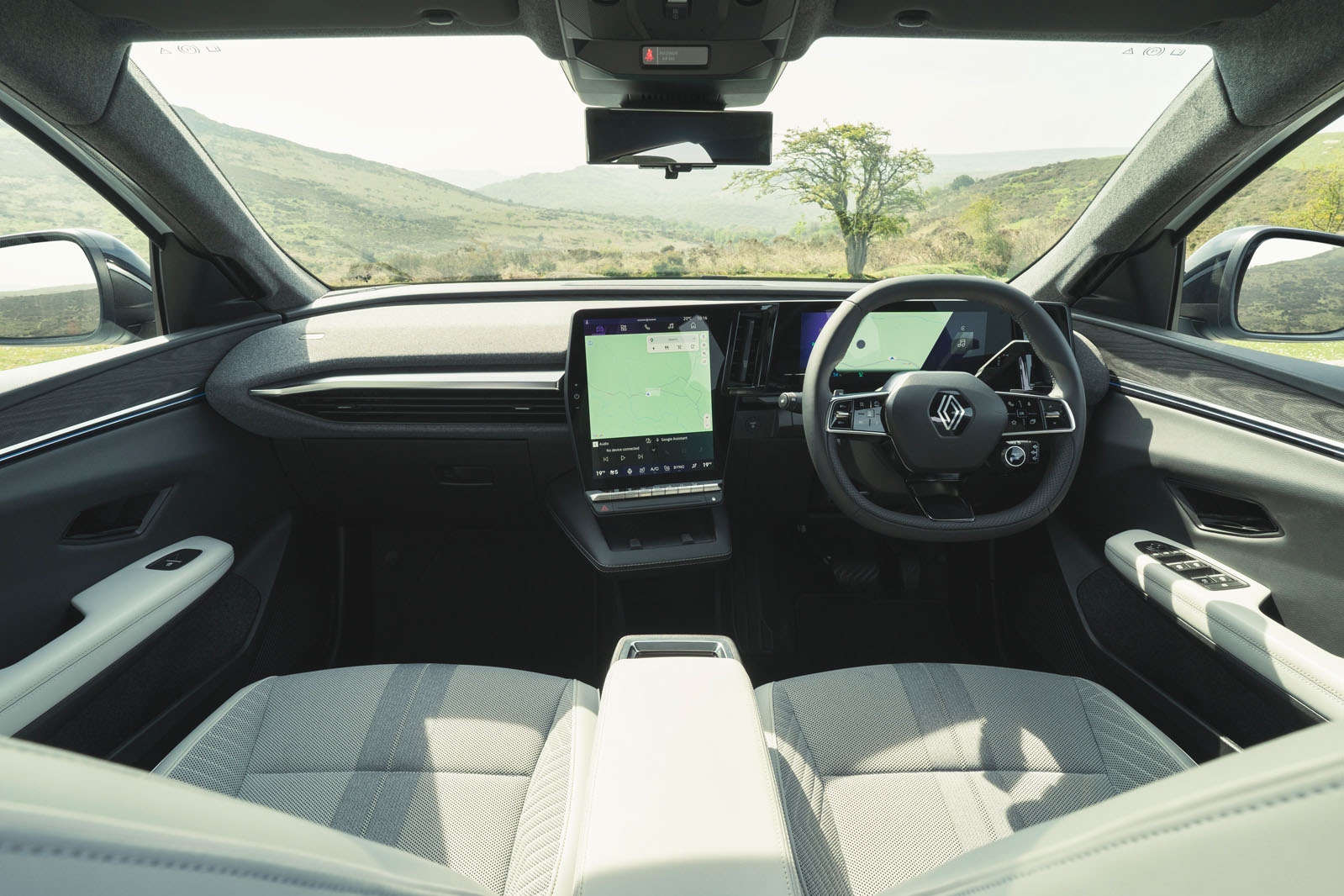
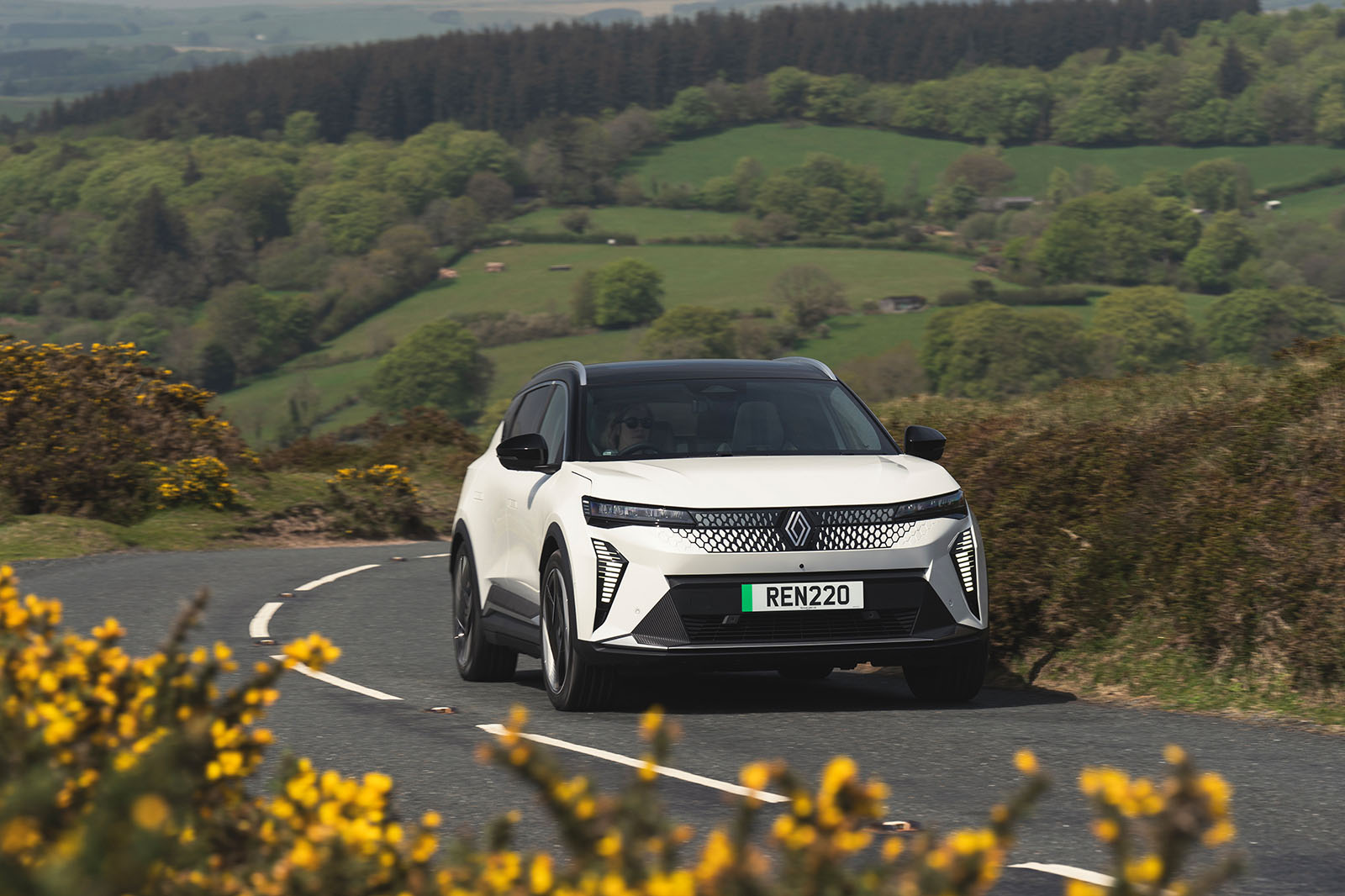
Submitted by dev_editor on
Submitted by dev_editor on
Submitted by dev_editor on
Submitted by dev_editor on